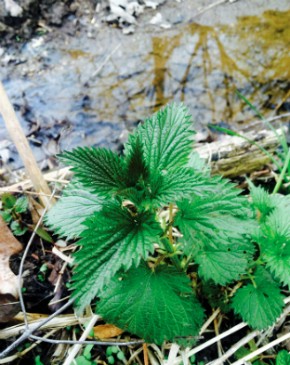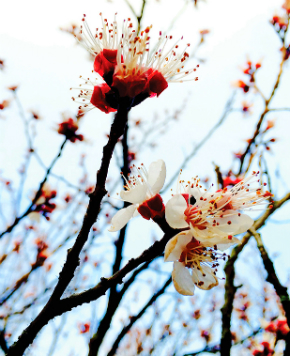The sting of spring: Notes from the farm

Walking our farmland on an unseasonably balmy mid-March day, I was surprised to see the cherry trees on the hill already in full and festive blossom, abuzz with butterflies and bees. In central Illinois, March is generally a cold, wet, and blustery month, the last hurrah of winter, more lion than lamb. But after an entire winter of warmer-than-usual temperatures, the woods were greening, wildflowers were blooming, and colorful butterflies had appeared, along with migrating birds adding their new melodic lines to each morning’s wake-up chorus.
Yet these bright signs of spring were accompanied by dark clouds. Insect pests had survived the mild winter and were ready to voraciously attack the new vegetable transplants. Butterflies had emerged prematurely and would likely not survive the harsh change from unseasonably warm to freezing cold that was sure to come, meaning they would die before having a chance to mate and lay their eggs. When April did indeed bring a number of nights in the mid-20s, the precocious tiny fruits of the early blossoming cherry, peach, and pear trees froze and fell to the ground. And so before the growing season has even begun, we know that this year will be almost entirely fruitless, with the possible exception of the later blooming apple varieties.
Read our latest issue or browse back issues.
Each day this spring seemed to bring new evidence that “the time is out of joint,” the natural world out of sync with millennia of predictable weather patterns. Those patterns effortlessly matched the cherry tree’s blossoming and the butterfly’s emergence with irrefutable springtime, allowing cherries to come to fruition, butterflies to flit and flirt, and the cycle of life to continue. These seemingly eternal and inevitable truths, however, are now questionable.
My brother Henry and many other farmers no longer speak of climate change in the future tense, as something that may or will happen, but rather as something that already has occurred, as in “our changed climate.” While climate change may still exist abstractly for most people—something that afflicts different neighborhoods, distant cities, future times—Henry has seen our formerly predictable weather patterns upended during the past quarter century of his farming career.
For example, in his first decade of farming, he never had to irrigate because he could rely upon the predictable pattern of thunderstorms coming through central Illinois every few weeks, each one providing an inch or two of life-giving rain. But in our new man-made climate, precipitation events are becoming more severe and more violent. It’s not that we are getting more rain than we used to overall but that the distribution of precipitation has changed. We suffer more and longer droughts when it doesn’t rain for long periods of time, but then when it does rain, watch out! The sky opens and dumps inches of rain in a matter of minutes rather than hours. Because the soil cannot absorb it fast enough, the water swiftly runs off the fields and into streams and creeks, taking tons of fertile soil with it.
Although there are large swings in precipitation and temperature, overall it’s getting warmer. The USDA hardiness Zone 5 we grew up in is now Zone 6 and will likely become Zone 7 within our lifetime. In other words, central Illinois today has the climate that used to be that of the St. Louis area. And in another few decades, we will have the climate of Dallas. (The Arbor Day Foundation has a simple visual representation of climate zone changes on its website.)
 |
Knowing the climate zone changes, my brother’s grounded observations, and my own witnessing of the cherry trees blooming early followed by the cherries’ early demise, I should not have been surprised to see the nettles poking up as I crossed the stream that separates Henry’s two ten-acre bottomland vegetable fields. But there they were, almost a month earlier than usual and already nearly a foot tall. Their dark green serrated leaves, growing in perfect pairs on either side of a ribbed hollow stem, were thrusting their way through last year’s dead grass and weeds. It was not yet April, but they were calling to me, so I began my spring ritual according to their schedule, not mine.
Harvesting wild greens always returns me to our species’ hunter-gatherer roots. It was not so long ago that this is what people did the world over, eagerly welcoming the first wild greens after a lean winter. As I bent over the prickly greens, I thought about the Native Americans whose arrowheads Henry’s plow sometimes turns up, and who gathered nettles here for millennia, until just a couple hundred years ago. They boiled them up and enjoyed their meaty taste and abundant nutrients first thing every spring when other food plants (including their “three sisters of life”—corn, beans, and squash) were still weeks away from being planted.
Most Europeans still consider nettles (Urtica dioica) a “spring tonic.” In Germany, where most research on the medicinal properties of plants now comes from, nettles are a common ingredient in herbal drugs for rheumatic complaints and inflammatory conditions (especially for urinary tract and prostate problems). Nettles have also been shown to alleviate allergies, help stimulate blood circulation, and clear chronic skin ailments. Some propose that nettles might even help prevent Alzheimer’s disease because they contain acetylcholine and choline, both deficient in the brains of people with Alzheimer’s. Nettles also contain serotonin, a mood enhancer—which we could all use as we contemplate a planet whose weather patterns will only become more unpredictable and more severe.
A proverb in the dialect of people from Carrara, Italy, states that whoever wants a good supper should eat a weed of every kind (Chi vo far ’na bona zena, i magn’un erb’d’tut la mena). And it’s not just a proverb, but a way of life in many parts of the world. In Puglia and Friuli, nettles still find their way into pasta and polenta, while in Rome they are most often found in risotto. I’ve found that if I don’t want to scare my family or guests, I just use the Italian name for nettles, ortiche (or-tea-kay), and everyone raves about the exotic, dark green, flavorful greens I mysteriously sourced.
Lest you think I’m a lunatic, or a masochist, let me assure you that I was wearing gloves as I gathered the nettles and that cooking completely destroys their sting.
The toothless, jawless nettle plant evolved an effective defense mechanism with its sting delivery system. On the surfaces of the leaves and stems are delicate hair-like needles. The tip of each needle is brittle, so when your fingers or ankles brush against it, it breaks off, and the sharp point penetrates your skin and delivers the stinging chemicals. But boiling water neutralizes the chemicals and also destroys the stinging structures, making the brittle hairs limp and unable to sting.
For many years, the nettle sting was thought to be formic acid, the same substance in the sting of red ants. But although formic acid is present, recent research has shown that the main stinging chemicals are histamine, acetylcholine, and serotonin, all of which are in fact very good things.
In addition, nettles are delicious, richer than spinach in flavor and in just about every nutrient from protein, to vitamins A and C, to the minerals iron, potassium, manganese, and calcium. And any dish you make with cooked spinach can be made with cooked nettles, from soup to vegetarian lasagna. (To cook, snip off the top four to six inches of the plants and wash them in cold water. Bring a pot of salted water to a boil, put the nettles in the pan, and cover with a tight lid. Cook gently for five to ten minutes. Chop the drained greens if you like, and then mix with butter, olive oil, salt, or pepper.)
With all these beneficial aspects of nettles, you’d think there’d be masses of people out harvesting them each spring. To the contrary, in the United States wild greens have been passively ignored or actively poisoned with herbicides.
But I’m willing to bet that as each year brings wilder temperature swings and heavier precipitation events with longer droughts in between, people will begin to appreciate nettles and other delicious plants formerly known as weeds. For starters, they don’t require us to plow, fertilize, plant, or tend them. And no matter what man, or man-altered, nature throws at them, they find a way to survive, even to thrive, when and where opportunity presents itself. From developing resistance to herbicides to carving out new niches in hostile environments, nettles and other “weeds” deserve our attention and respect. Their tenacity, adaptability, and resilience are part and parcel of the wild wisdom of nature, qualities we’ll need to cultivate as we enter an uncertain future.





